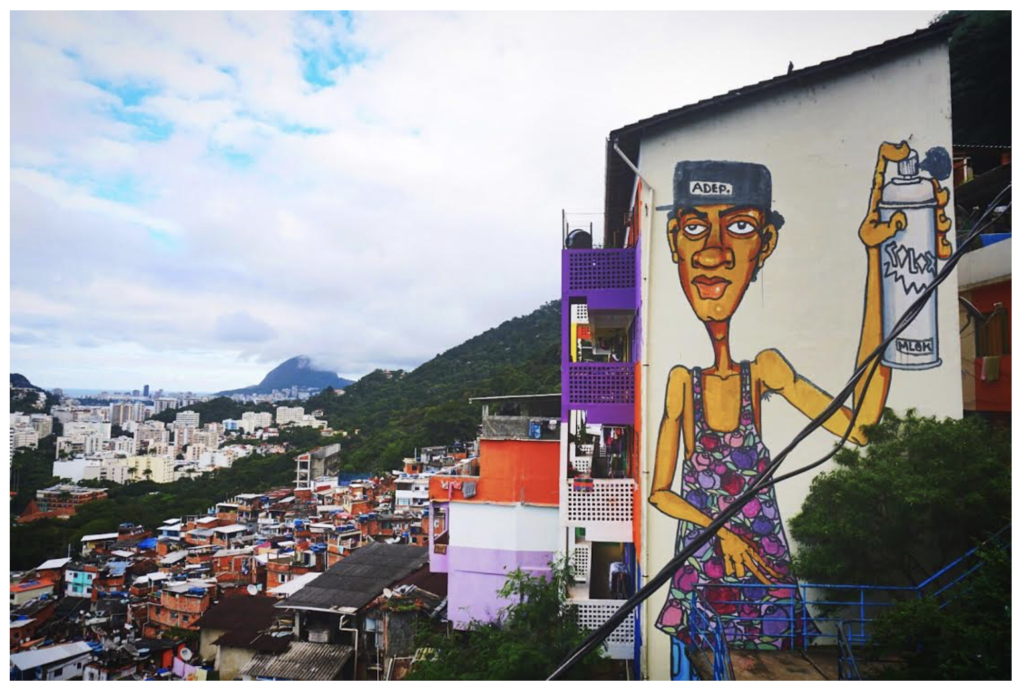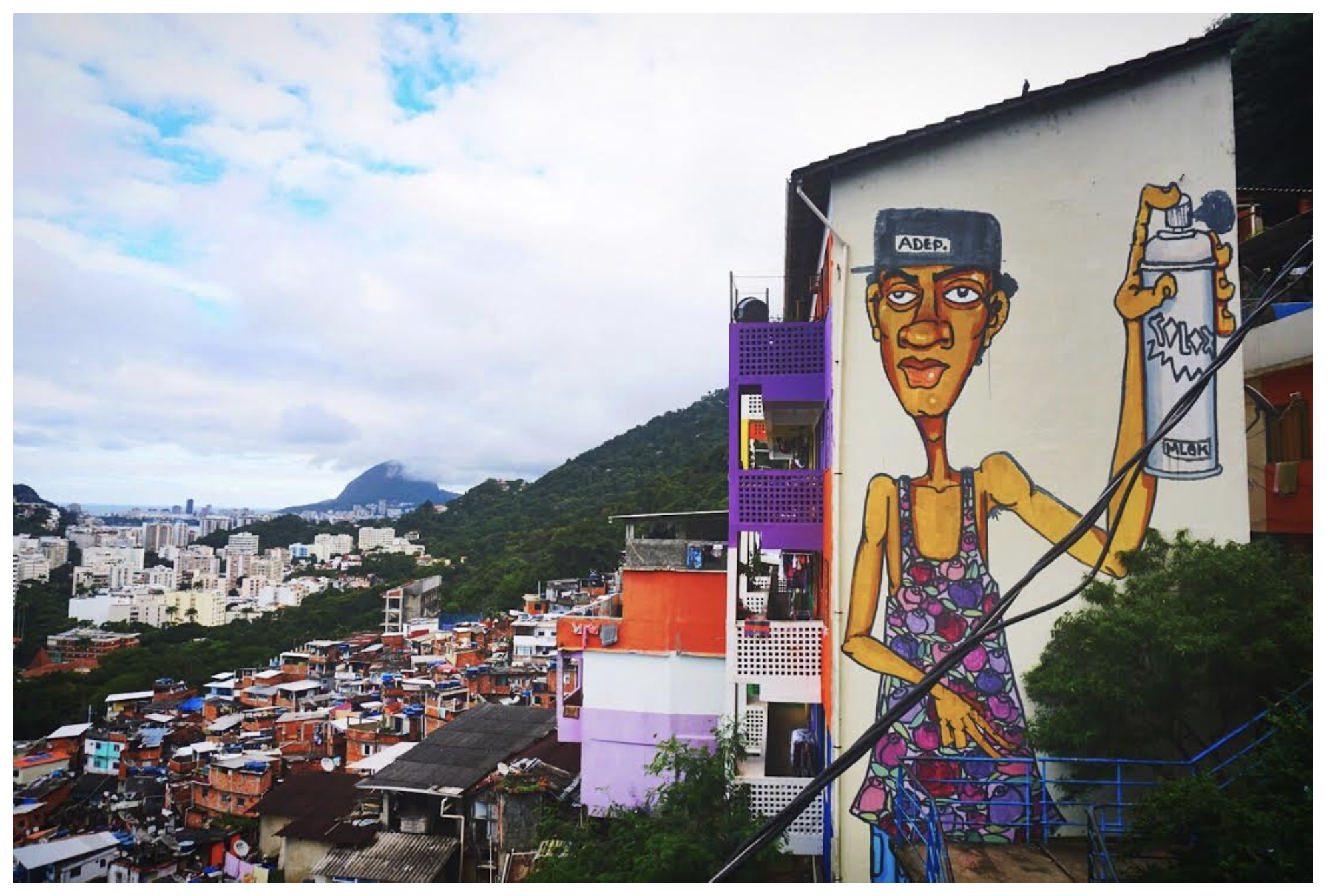Morrinho operates as a space for audiovisual learning, art education, youth leadership, and citizenship education. Morrinho functions as a space for professional and creative education. The goal is to bring positive change to the local community and contribute to the social-cultural and economic development of those who live in Pereirão. Morrinho takes its social practices around to different favelas, partnering with various favela-based programs and schools. During my time with Projeto Morrinho I was given the opportunity to participate in a three-day workshop with them in Santa Marta, Rio’s steepest favela.

Engagement: Santa Marta Workshop
About two weeks into working with the organization, fellow New School students Josh, Magdiela and I joined Cirlan, Savio, Honey, and Denise4 for a workshop that they were organizing with the community of Santa Marta. Santa Marta also known as Dona Marta, is a favela located in zona sul in between Laranjeiras and the neighborhood Botofogo. The favela is well known because in 1996 Michael Jackson filmed his video for the song “They Don’t Care about Us” at the top. The favela is one of the steepest in the city and a major recent infrastructure improvement was the construction of a funicular, a cable car that transports residents from near the entrance to locations with higher altitude.
In 2008 the favela began to host one of the city’s first Police Pacifying Units. Santa Marta has about 8000 residents, with 500 wooden houses, 2000 brick houses, 4 kindergartens, 3 bakeries, 2 sports fields, 1 block of a samba school, 3 military units and 1 small market. The favela is one of the steepest in the city. The favela is one that is frequented by tourists guided in groups who can shop at local gift stores and visit the famous Michael Jackson square, a public space among the poorest homes in that favela but with the best view of the city. While Santa Marta is pitched as Rio’s Model Favela, residents mentioned hostile relationships forming if they do not say good morning to the police every morning. “People around here are more afraid of the police then they ever were of the drug gang,” a feeling that even as an outsider resonates with me. By this time in the project we had become comfortable with walking up to Pereirão and would pass the boca do fumo and look out boys daily acknowledging the traffickers with a “bom dia or a boã tarde.” The first day that we got to the favela we were waiting for Cirlan to come to the entrance before we went up. While there was a tourism booth at the bottom there were also groups of 5-6 military police heavily armed. We all were hesitant to enter the favela, even though it is known as a “model favela.” A tour guide, a small white woman came up and asked us if she could take us up to the favela, when we denied her guidance because we were waiting for Cirlan to come get us at the entrance, she immediately started asking us why we were so afraid of the favela. I felt a sense of remorse when we realized she was working in collaboration with Morrinho and that we did not trust her from the start, but we had been taught by cariocas to be skeptical and aware when crossing the boundaries between the asphalt and the morro.
The workshop was three days. The first day we were tasked with carrying the Bahia Bricks from the entrance up the stairs to a little courtyard underneath the cable car station. The first day was the workshop where the artists showed the children the process of breaking the bricks and making them into houses for Morrinho. After several hours of painting, the youth finished and we stayed with the artists to finish the remaining bricks. The following day we spent much of the day avoiding the rain, the goal was to bring the bricks down to the station but if they got rained on the paint would smear and all of the work would be ruined. This day was very informative because we spent most of it with the artists and the women involved with the workshop eating sandwiches and talking about life. I asked one woman, for the purposes of this paper I will call her Luisa, how long she had been living in Santa Marta and she responded that she had moved there three months ago in hope that it would be safer for her children. She had left her previous home in Santa Teresa because one day her husband was shot dead at the door to their home in front of her children. He had been mistaken for a drug trafficker. Luisa’s story is one that is similar to many women living in Rio de Janeiro. She said the hardest part about living in Santa Marta is passing the occupying police force every day, forced to say good morning. She had three children participating in the workshop with Morrinho. We spent the rest of the day carrying bricks to the station. The workshop concluded with a block party showcasing the new installation of Morrinho and performances of Santa Marta Music School. There were hundreds of people there, maybe thousands, hard to distinguish who was there for the block party and who was there just to take the cable car home.
A very interesting part of the performances was an anti-drug skit presented by the mimes and theater-Morrinho, a component of the project I was only exposed to this time. I expected for this to be similar to the DARE presentations I endured during primary school but I was pleasantly surprised at how effective it was. There were two clowns, both who used some drugs at a club at the beginning of the skit, visibly having a great time. One clown fell into addiction, a role acted by a girl dressed in all black with dark makeup. At the end, the clown reached out his hand and all of the children ran over to him to pull him out, something that definitely was not planned. It was so beautiful and moving and I just thought it was such an interesting form of anti-drug education.

